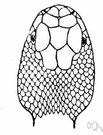Lizards represent about one-quarter of the diet of the
Sistrurus miliarius snakes in Florida.
It supports populations of the state endangered eastern massasauga (
Sistrurus catenatus), state threatened Kirtland's watersnake (Clonophis kirtlandii), black-billed cuckoo (Coccyzus erythropthalmus) and Mudpuppy (Necturus maculosus).
Assessment of Eastern Massasauga Rattlesnakes
Sistrurus catenatus in Berrien County Historical Sites.
Distribution and Status of the Western Pygmy Rattlesnake (
Sistrurus miliarius streckeri) in Tennessee.
Calvete, "Venom proteomes of closely related
Sistrurus rattlesnakes with divergent diets," Journal of Proteome Research, vol.
In particular, common rattlesnake (Crotalus and
Sistrurus genera) venom components include metalloproteinases, serine proteases, phospholipases [A.sub.2] (PL[A.sub.2]s), L-amino acid oxidases (LAAOs), Cysteine-Rich Secretory Proteins (CRISPs), C-type lectin-like, disintegrins and vasoactive peptides [5,6,10].
Both radiotelemetry and fiber-optic scopes have been used to locate hibernacula and observe
Sistrurus catenatus rattlesnakes (smith, 2009); however, their combined use has not been reported for study of lizards.
The eastern massasauga rattlesnake (
Sistrurus catenatus), has experienced range-wide population declines and is a candidate for listing under the U.S.
AND NASSER, H., 1999.An in vitro and in vivo study of some biological and biochemical effects of
Sistrurus Malarius Barbouri venom.
Nucleotide sequence of GSSG-TLE shows the highest homologies of 95.9% with calobin (Agkistrodon ussuriensis), 94.3% with TLE (Agkistrodon halys pallas), 90.7% with serine proteinase 6 (Adamanteus), 90.4% with serine proteinase (
Sistrurus catenatus edwardsi), 89.8% with serine protease 1 (Trimeresurus stejnegeri) and serine protease (Trimeresurus gramineus), 89.7% with serine protease KN7 precursor (Trimeresurus stejnegeri) and 89.6% with serine protease (Bothrops jararacussu) and TLE (Gloydius shedaoensis).
 Sistrurus - pygmy rattlesnakes
Sistrurus - pygmy rattlesnakes